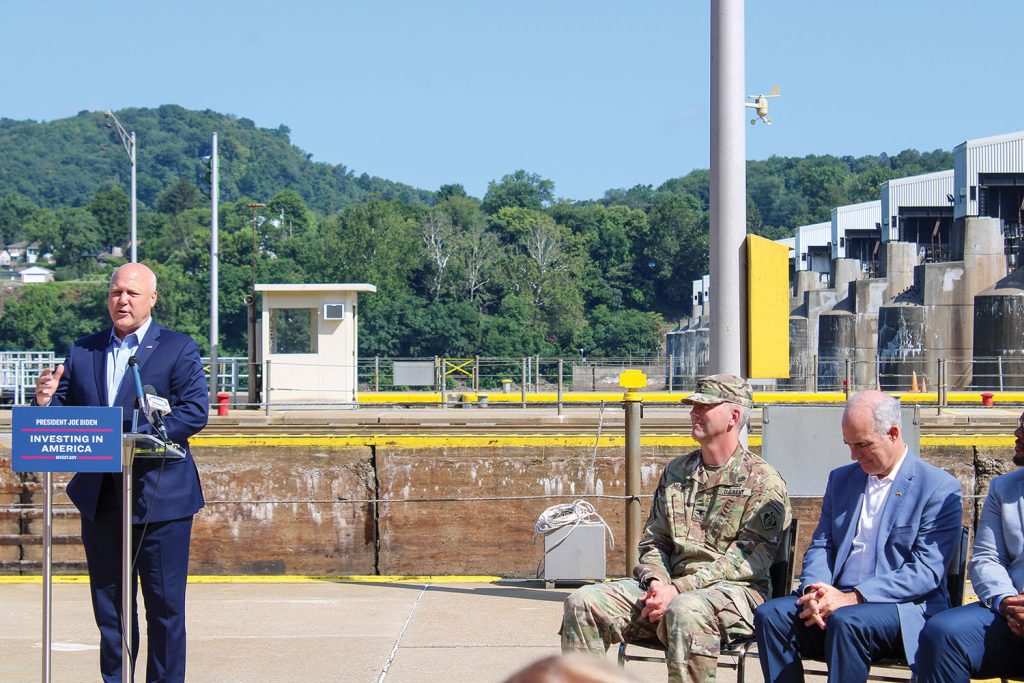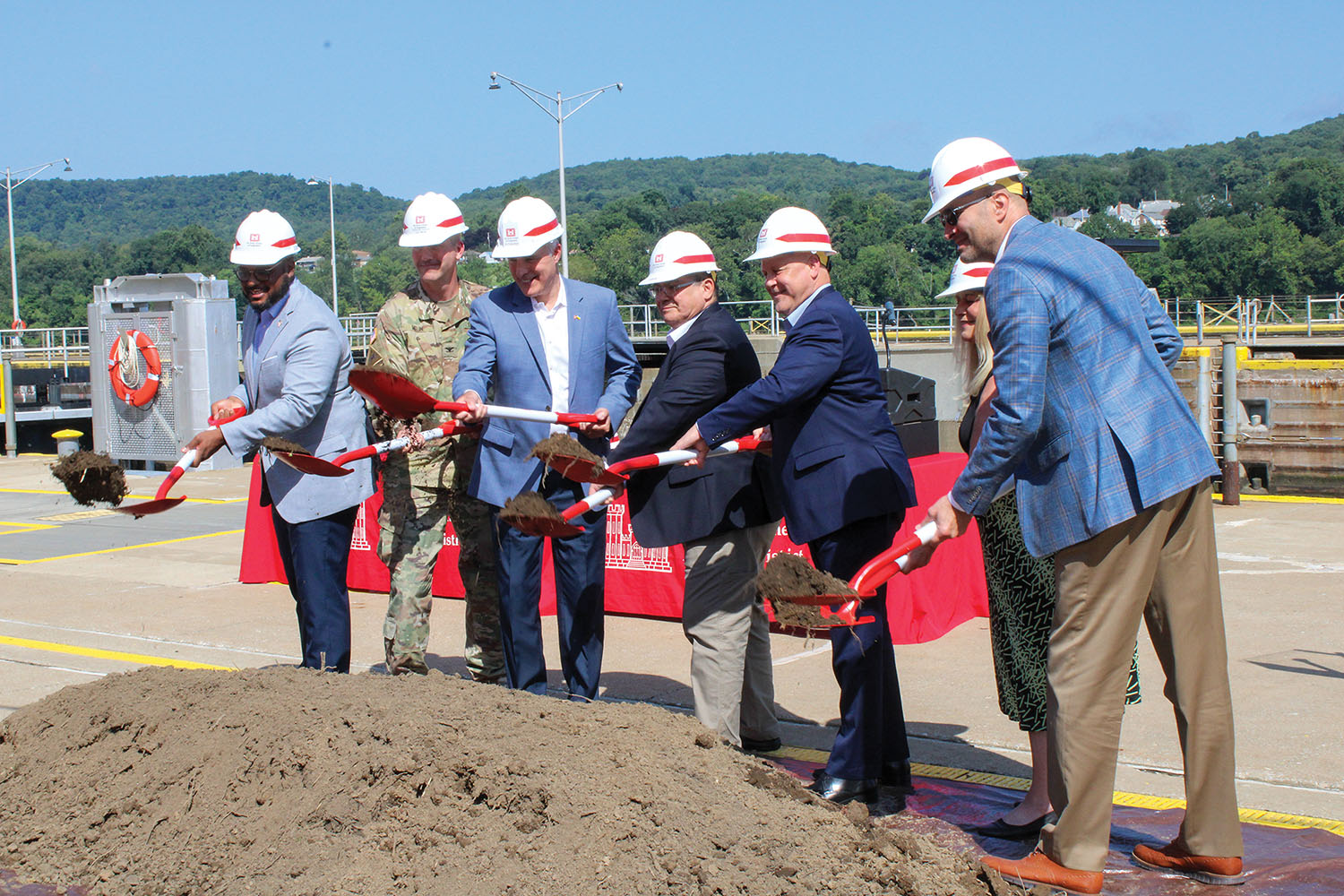The first shovels of dirt were turned ceremonially on August 11 at Montgomery Locks and Dam to mark the beginning of construction for phase one of the Upper Ohio Navigation Project.
Construction Plans
The project involves the first three locks and dams on the Ohio River downstream from Pittsburgh: Emsworth (Mile 6.2), Dashields (Mile 13.3) and Montgomery (Mile 13.7). Existing 360- by 56-foot auxiliary lock chambers, the smallest of all lock chambers on the Ohio River, will be replaced with new 600- by 110-foot chambers—the same size as existing main chambers—at each.
The Upper Ohio navigation system sees 15 to 20 million tons of materials pass through its river chambers annually, according to the Pittsburgh district. The Upper Ohio Navigation Project is expected to support 28,800 jobs over its construction life, and 5,400 jobs annually after completion.
Modernizing Navigation
Several federal, state and local officials toured the project site immediately before the ceremony, where several of them spoke.
Col. Nicholas Melin, who took over command of the Pittsburgh Engineer District one week prior, noted the history of the Corps of Engineers’ involvement in promoting safe navigation on the region’s rivers, calling it the district’s oldest and most enduring mission.
“Since 1866, the Corps has delivered practical solutions to travel from the headwaters of the Ohio year-round,” he said.
The Corps built the first dams in the late 1800s.
“They were old-style wooden wicket dams that raised the water level and made the river navigable for shipping in their era,” he said. “In 1932, new technology allowed the Corps of Engineers to replace those wooden dams with the gated concrete dams you see in front of you today, bringing the system into the 20th century.”
Construction at Montgomery began in 1932 and was completed in 1936.
Then Melin turned to plans for the three new lock chambers.
“Today we’re here to break ground on phase one of a historic, long-term project to modernize inland navigation on the upper Ohio River again,” he said.
Work Underway
At times, Melin had to raise his voice over the sounds of heavy equipment already moving dirt at the site for a concrete batch plant, which will produce 400,000 cubic yards of concrete for the project.
“That’s the equivalent of a concrete block that’s the size of a football field and 20 stories high, and that concrete block would weigh 1.6 billion pounds,” he said.
The project schedule calls for design at Montgomery to continue through the end of this year and for a contract for the new riverside chamber to be awarded toward the end of 2024, Chris Dening, the project manager for the construction of the Upper Ohio project, told the Inland Waterways Users Board last month. Design at Emsworth has begun and is to continue through 2025. Construction at Emsworth is scheduled to take place from 2032-2042. Design at Dashields is to take place 2025-2027 with construction there anticipated for 2043-2051.
“Providing a solid navigation system for the next 100 years begins here at Montgomery Locks and Dam, where we stand today, and continues with the upgrading of Emsworth and Dashields locks and dams,” Melin told the crowd at the groundbreaking ceremony. “All three facilities will get larger lock chambers, bringing navigation in the upper Ohio River into the 21st century.”
He added that the locks provide a safe, efficient, cost-effective and more environmentally friendly method for transporting large volumes of commodities than any other system of bulk transport.
Melin also noted that the project would not have been possible without the funding included in the Infrastructure Investment and Jobs Act (IIJA).
However, while that money was previously expected to fund construction of the new lock at Montgomery to completion, a new certified cost estimate completed by the Corps on June 16 estimates the Montgomery work to cost roughly $1.7 billion, an addition of $513 million to the original estimate, more than doubling the original anticipated cost for the new lock.
Melin also thanked the team of professionals who have been working on the project, noting that it has taken more than a decade of dedicated effort from an interdisciplinary team to bring the project to the start of construction.
“This team has delivered a solid plan that we’re now ready to execute,” he said.
Moving Forward
Sen. Bob Casey (D-Pennsylvania), who has been one of the project’s biggest congressional backers, also spoke at the ceremony. He called the day a celebration of a commitment of investment for what he called a critically important project not just for the region or state but for a significant portion of the United States.
“We cannot allow this system to fail,” he said. “Too many lives, too many jobs, too many opportunities depend upon the investment that we’re making here.”
The work being done will result in good-paying jobs as well as improvements in commerce and transportation, he said.
“The investment we make today will pay dividends not for years or decades but for generations to come, and it’s long, long overdue,” he said.
However, he also acknowledged there is more work yet to be done to ensure the work is funded to completion.
Other Speakers
Pennsylvania Lt. Gov. Austin Davis said the Upper Ohio Navigation Project was an example of what could be accomplished by working together.
“Working together, we are going to rebuild this country’s infrastructure,” he said.
Jaime Pinkham, principal deputy assistant secretary of the Army for civil works, said the Upper Ohio Navigation Project is a critical piece of the supply chain and its upstream and downstream flow of commerce “powering the heart of the industrial base here in Pittsburgh and then launching distribution downstream and beyond.”
He added that, in order to succeed, infrastructure must be modernized and resilient.
“Our inland waterways are a critical artery sustaining the nation’s economy and families by delivering goods to our homes, connecting us to global markets, and bolstering employment,” he said. “The investments we are making today will reinvigorate navigation and make it resilient to provide significant benefits for years to come.”

Finally, Mitch Landrieu, White House infrastructure coordinator, spoke about the $1.2 trillion in federal investment contained in the IIJA, with 37,000 projects currently underway in 4,500 communities in all 50 states. He also spoke about the importance of continuing that work and ensuring the resiliency of the supply chain by “moving commerce from ships to shelves,” noting that is why IIJA contained $857 million for the Montgomery project and more than $1 billion for the Upper Ohio Navigation Project as a whole.
“This is just an incredible waterway that’s critically important to the economy of the entire United States of America,” he said.




